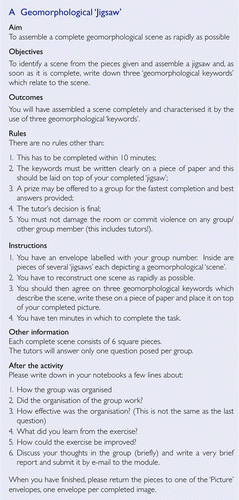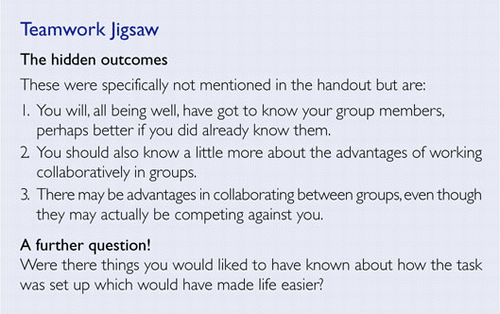Abstract
This paper describes an ‘icebreaker’ used at the start of a final year geomorphology module. Teamwork was designed to be an important component of a module which involved a mix of problem-based and curriculum-mode learning. Each team had to collect and reassemble six parts of one of several images dispersed amongst the class. The instructions were given in written form for the exercise which was designed to take 20 minutes, including a review and feedback period. The aim of the exercise was to show that even a simple task required appreciation of the need to work collaboratively in a team.
Introduction
In the School of Geography at Queens University Belfast, we were starting a module for final year students which had previously run in a fairly traditional manner. The module, ‘Applied Geomorphology’ examined selected geomorphological environments and used case studies from these environments to develop students understanding of the interaction between humans and the landscape. A variety of practical, modelling and analytical techniques are employed to examine and evaluate selected applications of geomorphology.
By the end of the module students should be able to:
Understand basic approaches to the application of geomorphological concepts to real-world problems;
Appreciate the use of laboratory methods to solve practical geomorphological problems;
Use simple numerical models to analyse data and to report on findings;
Produce professionally-oriented, illustrated short reports based upon the evaluation of field and laboratory data;
Work in groups and singly to evaluate real-world case studies.
In 2003 we decided, after some deliberation, to set the module largely in the context of problem-based learning and group-work involvement. The value of using problem-based approaches has been shown to be worthwhile in enhancing student learning for some time (e.g. CitationBoud, 1988) and increasingly in a GEES-context (e.g. CitationSavin-Baden, 2001; Blumhoff et al., 2001). Teamwork is often used as part of PBL and we wished to show students the importance of teams as a means of enhancing learning as well as solving problems.
Although some group-work had been done with students at various stages earlier in the undergraduate programme, there was no module which specifically emphasised teamwork. Hence, the first meeting of the Applied Geomorphology module included a general discussion about team skills. To give an illustration to this talk about team-building skills, the author devised the following exercise as an ‘icebreaker’, to be done in about 20 minutes (10 minutes for the exercise and 10 minutes for debriefing.) Although the exercise described here is based around a geomorphological theme, GEES academics could easily use other images to suit their own modules.
Rationale
CitationRace (2001, p172) gives pointers to successful groupwork as well as ideas for ‘icebreakers’. Here, the rationale for the icebreaker was to introduce team working to the groups they would be in for practical sessions and field work. It was intended to demonstrate something about group dynamics, For example, how should teams organise themselves and keep to time? How is inter-team collaboration achieved for the successful completion of a task? Is team competition an issue? As the initial groups were randomly assigned, this icebreaker was considered as a first step the integration as well as illustrating some of the collaboration required. The word ‘teamwork’ has been used here rather than ‘groupwork’. Groups had been used in this module before, to carry out a laboratory experiment or collect data in the field for example. However, the distinction has been made to see if groups can be converted into teams; collaborating and learning together rather than just doing some necessary task as a collection of individuals.
The Exercise
The handout, re-produced overleaf in , was given to each student group (ten groups of about 4 students per group). Then they were simply asked to get on with it!
In this example, thirteen scanned images were selected and then printed in colour in landscape format onto card (approx. dimensions are 27 cm × 18 cm). Each print was then trimmed to be of the same size and then cut into 9 cm × 9 cm squares, to give 6 small squares. Thirteen A5 envelopes were marked with group numbers 1–13 (even though there were only 10 groups) and a random selection of 6–7 squares were placed in each envelope from all of the images used. Of course, the contents of any one envelope do not make up a complete image! The trick for the teams is to remember what scene pieces they have, observe what others have, and then to haggle or negotiate exchanges so that they can make up their complete geomorphological scene.
Some Observations and Comments
The exercise seems to work quite well, although it was a bit novel and even puzzling for the students at first! They were told a minimum of information. Strangely (or perhaps not!), only one group asked a question- about whether they could look into one of the ‘spare’ envelopes. This fact was used subsequently to illustrate that asking for more information was a perfectly acceptable procedure in problem-solving.
After completion of the scene, the rubric asked for three geomorphological keywords to be presented. Sometimes a first submission was rejected as not being geomorphological enough. This task could have been made more difficult as a means for developing an idea for subsequent discussion of a problem or even a further teamwork exercise.
It is not difficult to think of variations on this scheme; duplicates of some images, some images incomplete, all images incomplete etc. I tried to make it not entirely easy by having some scenes which were rather similar. The main aim, however, was just to get some collaboration going!
An additional note was distributed to the students after the session; this is also reproduced overleaf in .
I did not insist on the e-feedback (see ) perhaps I should have as we were using e-communication in the module - but that’s another story! However, subsequent ‘Critical Incident Questionnaires’ showed that working in teams is not a natural thing for students to appreciate, despite encouragement to the contrary (e.g. CitationKneale, 1999, p135). The debrief session showed that, previously, students were only used to working in groups for specific tasks such as a practical class. They did not appreciate the real value of working in teams (whether with a PBL approach or not) even though we had said this was a skill encouraged by employers (e.g. CitationLynch, 2002). They thought that emphasis on team skills at an earlier stage in their university careers would have been useful.
Conclusion and Recommendations
An exercise such as this will certainly not engender team working on its own. Indeed, there is no guarantee that this sort of exercise will work at all! However, it was probably worth the short time involved. I am now thinking of ways in which a more extensive project could be built up in a similar way, for example, exchanging data between teams to produce a lab-field report on properties of materials. This would be used as a reinforcement later in the module, be assessment driven and make the exchange and working up of data the main task rather than an ancillary task as it has been previously.
Team working perhaps needs to be developed at an earlier stage than final year and become more embedded in modules, even if only a small amount, and complementary to the team working that is often used in field classes. Team work is different from working in groups and is probably more difficult to establish within a learning environment. Therefore a preliminary exercise such as described here can be used to help in setting the scene.
References
- BlumhoffJ., HallM. & HoneybourneA. (2001). Using Problem-Based Learning to Develop Graduate Skills. Planet, Special Edition 2: 6-9.
- BoudD. (1988). Moving towards autonomy, In D.Boud, D. (Ed.) Developing Student Autonomy in Learning (2nd edition) London: Kogan Page
- KnealeP. E. (1999). Study Skills for Geography Students. London: Arnold
- LynchK. (2002). Team-Based Learning Staff Development Materials. Planet, 4: 623-624.
- RaceP. (2001) The Lecturer’s Toolkit. London: Kogan Page
- Savin-BadenM. (2001). The Problem-Based Learning Landscape. Planet, Special Edition, 2: 4-6.

